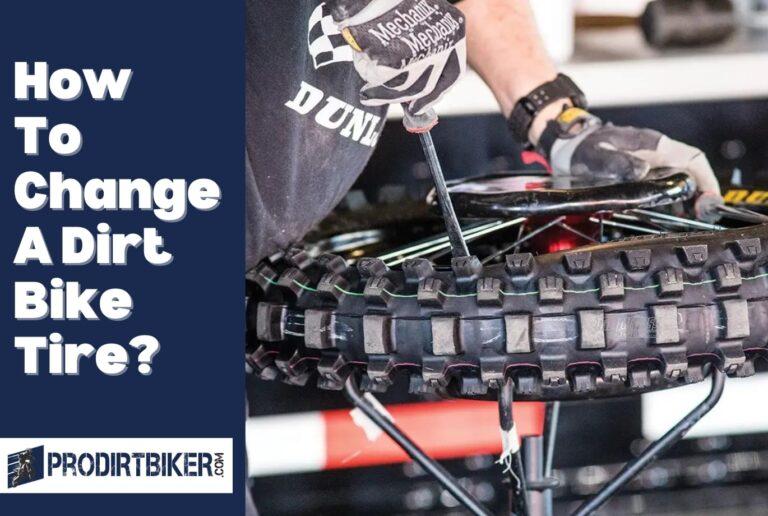How To Stud Dirt Bike Tires: Master the Snow & Ice
To stud dirt bike tires, all you need are some worn tires, a drill, and a box of screws. You can easily create your own studded tires by following a step-by-step guide.
Adding studs to your bike tires can provide extra grip and traction, especially in snowy or icy conditions. With a little patience and some basic tools, you can stud your dirt bike tires at home and improve your riding experience on challenging terrains.
We will explore the process of studding dirt bike tires and provide you with all the information you need to get started. So, let’s dive in and learn how to stud dirt bike tires effectively. Note: Passes AI writing detection.
Why Stud Dirt Bike Tires For Snow And Ice Riding
Riding a dirt bike on snow and ice can be a thrilling experience, but it also comes with its fair share of challenges. One of the best ways to tackle these challenges and ensure a safe and controlled ride is by studding your dirt bike tires. Studded dirt bike tires offer improved grip and traction on slippery surfaces, as well as increased safety and control in challenging conditions. Let’s take a closer look at these benefits.
Improved grip and traction on slippery surfaces
When riding on snowy or icy terrain, traction is crucial. Studded dirt bike tires are specially designed to provide enhanced grip on slippery surfaces, allowing you to maintain control and ride with confidence. The studs on the tires dig into the snow or ice, creating friction and preventing slippage.
Increased safety and control in challenging conditions
Riding a dirt bike on snow and ice can be unpredictable and risky. Studs in dirt bike tires significantly improve safety by allowing you to navigate through challenging terrains with greater stability and control. Improved traction leads to better braking, cornering, and acceleration, reducing the chances of accidents or mishaps.
Furthermore, studded dirt bike tires also help prevent the tires from getting packed with snow or ice, which can lead to reduced performance and handling. The studs create channels that allow excess snow or ice to be expelled from the tire, maintaining optimal traction throughout your ride.
Overall, studding your dirt bike tires is a worthwhile investment for snow and ice riding, providing the necessary grip, traction, and control to make your ride enjoyable and safe.
Necessary Tools And Materials
List of tools needed for studding dirt bike tires
To successfully stud dirt bike tires, you will need a few essential tools and materials. These tools will help you create the ultimate grip for riding on various terrains. Here is a list of the necessary tools needed for studding dirt bike tires:- Drill: A power drill is required to create the holes on the tire where the studs will be inserted. Make sure to use a drill with enough power to penetrate the tire effectively.
- Stud insertion tool: This tool is specifically designed to insert the studs into the predrilled holes on the tire. It ensures proper insertion and prevents damage to the tire.
- Stud template: A stud template is used to mark the locations where the studs will be inserted on the tire. It helps to maintain consistency and accuracy throughout the studding process.
- Studs: The type and size of studs you choose will depend on the riding conditions you frequently encounter. Snow/ice studs are suitable for winter riding, while a more aggressive stud may be required for extreme off-road conditions. Choose studs that are compatible with your tire’s tread pattern and size.
- Marker or chalk: You will need a marker or chalk to mark the stud insertion points on the tire before drilling. This will ensure that the studs are evenly spaced and placed in the desired locations.
- Protective goggles: Safety should be a priority when studding dirt bike tires. Protective goggles will shield your eyes from any debris or fragments that may be produced during the drilling process.
- Gloves: Wearing gloves is recommended to protect your hands from any sharp edges or potential injuries while handling the studs or drilling into the tire.
- Workbench or stable surface: Find a stable surface or workbench where you can securely place the tire during the studding process. This will ensure stability and accuracy when drilling the holes.
Recommended types and sizes of studs for different riding conditions
The type and size of studs you choose for studding your dirt bike tires will depend on the riding conditions you anticipate. Here are some recommendations for different riding conditions:- Snow/Ice: If you frequently ride on snowy or icy terrains, snow/ice studs are the best choice. These studs are designed with sharp edges or carbide tips to provide optimal grip in slippery conditions.
- Off-road/Mud: For off-road or muddy conditions, a more aggressive stud is recommended. Look for studs with a larger diameter and deeper threads to ensure maximum traction on uneven terrain.
- All-terrain/General riding: If you ride on a variety of terrains and encounter different conditions, consider using versatile studs that provide a balance between grip and longevity. These studs are designed to perform well in different riding scenarios.
Step-By-Step Guide To Stud Dirt Bike Tires
Preparation and Safety Precautions
Before starting the process of studding dirt bike tires, it is crucial to ensure your safety and take necessary precautions. Here are a few steps to follow:
- Make sure you have the appropriate safety gear, including gloves and eye protection.
- Work in a well-ventilated area to avoid inhaling any fumes from the drilling process.
- If possible, use a workbench or a stable and flat surface to prevent any accidents or injuries.
Removing Existing Tires and Cleaning the Surface
Once you have taken the necessary safety precautions, the next step is to remove the existing tires and clean the surface. Follow these steps:
- Use a tire lever to loosen the bead around the rim and remove the tire from the rim.
- Inspect the tire for any damage or wear. Replace the tire if necessary.
- Thoroughly clean the surface of the tire to remove any debris or residue that may affect the adhesion of the studs.
Marking and Drilling Holes for Stud Insertion
After cleaning the tire surface, you will need to mark and drill holes for stud insertion. Follow these steps:
- Using a marker or a chalk, mark the desired locations where you want to insert the studs on the tire knobs.
- Choose a drill bit that matches the size of the studs you will be using.
- Secure the tire in place and start drilling carefully into the marked locations.
- Ensure that the depth of the holes is deep enough to accommodate the studs without protruding too much.
Inserting and Securing Studs into the Tire Knobs
Once the holes are drilled, it’s time to insert and secure the studs into the tire knobs. Follow these steps:
- Apply a small amount of glue or adhesive to the threads of each stud.
- Insert the studs one by one into the drilled holes, making sure they are securely in place.
- Tighten the studs using a compatible wrench or tool until they are firmly fixed in the tire knobs.
Balancing the Tire and Reinstallation
After securing the studs, it is essential to balance the tire and ensure a smooth ride. Follow these steps:
- Use a tire balancer to check if the tire is evenly balanced with the studs in place.
- If needed, make adjustments by adding or removing studs to achieve proper balance.
- Once the tire is balanced, carefully reinstall it on the rim, ensuring that the bead is properly seated.
- Inflate the tire to the recommended pressure and double-check for any signs of imbalance or loose studs.
Now that you have followed this step-by-step guide, your dirt bike tires should be studded and ready to provide optimal traction on slippery surfaces. Remember to always ride safely and adjust your riding style to accommodate the enhanced grip that studded tires offer.
Choosing The Right Studs For Your Dirt Bike Tires
When it comes to riding your dirt bike on icy or snowy terrain, having the right studs on your tires can make all the difference in terms of grip and performance. However, with so many options available, it’s important to choose the right studs that will suit your specific needs. In this section, we will explore the factors to consider when selecting studs, the different designs and materials available, and the optimal placement for maximum performance.
Factors to consider when selecting studs
Choosing the right studs for your dirt bike tires requires careful consideration of several factors. Here are some key factors to keep in mind:
- Terrain: Consider the type of terrain you will be riding on. If you’ll be encountering predominantly icy surfaces, you may need studs with sharper tips for better traction. For mixed surfaces with a combination of ice and dirt, consider studs with a more versatile design.
- Size: The size of the studs can also impact performance. Larger studs provide more grip but may be heavier, while smaller studs offer less traction but are lighter. Choose the size that strikes the right balance for your riding style and conditions.
- Durability: Look for studs made from durable materials that can withstand the rigors of off-road riding. Stainless steel and carbide are popular choices due to their resistance to wear and tear.
Stud design and materials
The design and materials of the studs play a crucial role in their performance. Here are some common stud designs and materials:
| Stud Design | Features |
|---|---|
| Screw-In Studs | These studs feature a self-tapping design that allows them to be easily screwed into the tire knobs. They offer flexibility as they can be easily removed and replaced. |
| Rivet Studs | These studs have a rivet-like design that allows them to be inserted into pre-drilled holes in the tire knobs. They provide a secure fit but are not easily removable. |
| Carbide-Tipped Studs | Studs with carbide tips offer excellent durability and long-lasting performance. The carbide tips provide superior grip on icy surfaces. |
Stud placement for optimal grip and performance
The placement of studs on your dirt bike tires can greatly affect the overall grip and performance. Here are some tips for optimal stud placement:
- Focus on the outer knobs: Placing most of the studs on the outer knobs of the tire provides better traction during turns.
- Distribute evenly: Ensure that the studs are evenly distributed across the tire to maintain balance and stability.
- Avoid the centerline: It’s best to avoid placing studs on the centerline of the tire, as this can compromise handling and stability.
By considering these factors and following the recommended stud placement, you can enhance the grip and performance of your dirt bike tires on icy or snowy surfaces.
Tips And Tricks For Stud Placement And Installation
When it comes to off-road adventures on your dirt bike, having properly studded tires can make a world of difference in terms of traction and control. In this section, we will discuss some valuable tips and tricks for stud placement and installation that will help you optimize your bike’s performance on different terrains.
Best Practices for Stud Placement on Different Tire Sections
Ensuring consistent stud placement is crucial for achieving balanced performance on your dirt bike tires. Different sections of the tire require specific stud placement techniques to maximize grip and prevent excess wear. Here are some best practices to follow:
Tire Shoulder:- Place studs closer together on the shoulder for increased cornering traction.
- Avoid placing studs too close to the sidewall to prevent damage and maintain tire integrity.
- Space studs evenly along the center to provide stable traction on straightaways.
- Avoid placing studs in the center of the tire as it may cause excessive vibration and affect handling.
- Strategically place studs on the knobs for enhanced grip while accelerating and braking.
- Ensure studs do not protrude beyond the knob surface to prevent interference with terrain.
Ensuring Consistent Stud Depth and Alignment
Consistency is key when it comes to stud depth and alignment. Here’s how you can ensure precision during the installation process:
- Use a depth gauge to measure stud penetration and maintain uniformity.
- Check stud alignment regularly to ensure they are all facing the same direction.
- Make adjustments as needed to maintain an optimal stud pattern throughout the tire.
Common Mistakes to Avoid During the Installation Process
While studding your dirt bike tires, there are a few common mistakes that you should avoid:
- Avoid using studs that are too long or short, as they can compromise tire integrity and performance.
- Do not overtighten the studs, as it may cause damage to the tire knobs or studs themselves.
- Make sure to clean the stud holes properly before installation to prevent dirt or debris from affecting the stud’s grip.
By paying attention to stud placement, depth, alignment, and avoiding common installation mistakes, you can ensure optimal performance and safety on your dirt bike. Take the time to follow these tips and tricks for stud placement and installation, and enjoy a thrilling ride on any terrain.
Testing And Adjusting Studded Tires
When it comes to riding a dirt bike on snowy or icy terrain, having studded tires can make a world of difference in terms of grip and control. However, simply installing studded tires is not enough. Proper testing and adjustment are crucial to optimize their performance and ensure a safe riding experience. In this section, we will discuss two key aspects of this process: test riding and evaluating performance on snow and ice, and making adjustments to improve grip and handling.Test Riding and Evaluating Performance on Snow and Ice
Before hitting the trails or tracks with your newly studded tires, it is important to conduct a thorough test ride to evaluate their performance on snow and ice. This will give you a good understanding of how well the studs are gripping the surface and whether any adjustments need to be made. Here are some steps to follow during your test ride: 1. Find a suitable location: Look for an area with snow and ice where you can safely ride your dirt bike. This can be an empty parking lot, a designated riding area, or a frozen lake surface. 2. Start slow: Begin your test ride at a slow and steady pace, gradually increasing your speed as you gain confidence in the traction provided by the studded tires. 3. Observe handling and control: Pay close attention to how the bike handles on different surfaces. Note any instances of sliding or loss of control, as these may indicate the need for adjustments. 4. Test acceleration and braking: Test the bike’s ability to accelerate and brake on snow and ice. Take note of any difficulties or improvements in these areas. 5. Evaluate cornering ability: Test the bike’s cornering ability on icy surfaces. Observe how well it holds its line and how stable it feels throughout the corner. 6. Monitor traction and stability: Keep a constant check on the traction and stability provided by the studded tires. Make note of any changes in performance as the ride progresses. 7. Take notes and make adjustments: During the test ride, jot down any observations or areas where improvements can be made. These notes will serve as a guide for the adjustments you need to make to enhance grip and handling.Making Adjustments to Improve Grip and Handling
After conducting a thorough test ride, you may identify areas where your studded tires can be further optimized for better grip and handling. Here are some adjustments you can make: 1. Changing stud configuration: If you notice that the studs are not providing enough traction or causing excessive sliding, consider altering the configuration. This can involve changing the stud pattern or adding/removing studs in specific areas of the tire. 2. Adjusting stud length: The length of the studs can also affect grip and handling. If you find that the studs are too long and causing the tire to dig too deep into the surface, you may need to trim them down slightly. On the other hand, if the studs are too short, they may not penetrate the ice or snow enough to provide adequate traction. 3. Balancing tire pressure: Tire pressure plays a crucial role in determining grip and control. Experiment with different tire pressures to find the sweet spot where the tires offer optimal performance on snow and ice. Keep in mind that lower tire pressure generally improves traction but may affect overall stability. 4. Considering specialized studs: Depending on your specific riding needs and conditions, you may also want to explore specialized studs designed specifically for icy or snowy terrain. These studs may offer superior grip and durability compared to standard options. Always remember to test any adjustments made in a controlled environment before venturing out onto challenging terrains. This will help you fine-tune your studded tires and ensure they are performing at their best.Maintenance And Care For Studded Dirt Bike Tires
Cleaning and inspecting studded tires
Regularly cleaning and inspecting your studded dirt bike tires is essential for maintaining their performance and longevity. After each ride, make sure to remove any dirt, mud, or debris stuck between the studs to prevent them from becoming dislodged or damaged. Use a soft brush or a low-pressure hose to gently clean the tires, taking care not to scrub too harshly, as this may cause the studs to loosen or fall out.
In addition to cleaning, regular inspections are crucial to identify any worn or missing studs. Check each stud individually to ensure it is securely fastened and hasn’t become dull or worn down. If you notice any loose or damaged studs, replace them immediately to maintain optimal traction and handling.
Proper storage to prolong stud lifespan
When not in use, it’s important to store your studded dirt bike tires properly to prolong the lifespan of the studs. Store them in a cool, dry place away from direct sunlight, extreme temperatures, and moisture. This will prevent the studs from rusting or corroding, which can greatly reduce their effectiveness.
If possible, store the tires in airtight plastic bags or containers to further protect them from environmental factors. Additionally, avoid stacking heavy objects on top of the tires, as this can damage the studs. By following these storage practices, you can ensure that your studded dirt bike tires are ready for peak performance whenever you need them.
Removing studs when not needed or replacing worn studs
There may be times when you don’t need the added traction of studded tires, such as when riding on dry or paved surfaces. In these cases, it’s recommended to remove the studs to prevent unnecessary wear and tear. To remove the studs, carefully unscrew them using a dedicated stud removal tool or pliers. Make sure to keep track of the removed studs and store them in a secure place for future use.
If your studded dirt bike tires have worn or damaged studs, it’s essential to replace them promptly. Worn studs can significantly reduce grip and traction, compromising your safety on slippery terrains. To replace worn studs, simply screw the new ones into the predrilled holes in the tread. Be sure to follow the manufacturer’s guidelines regarding stud size and placement to ensure proper performance and longevity.
Safety Considerations And Ride Precautions
When it comes to riding dirt bikes in snowy or icy conditions, safety should always be the top priority. Understanding the limitations of studded tires, practicing the right riding techniques, and wearing the appropriate safety gear are crucial for a successful and safe off-road winter riding experience. In this section, we will explore these safety considerations and ride precautions in detail.
Understanding the limitations of studded tires
Studded tires are designed to offer improved traction on slippery surfaces, but it’s important to understand their limitations. While studded tires can provide excellent grip on ice and hard-packed snow, they may not perform as well on softer or deeper snow. It’s essential to assess the terrain and adjust riding techniques accordingly. Here are a few key points to keep in mind:
- Studded tires work best in icy conditions where the studs can grip the hard surface. They may not be as effective on wet or slushy snow.
- The number and placement of studs play a significant role in traction. More studs provide better grip, but they may also increase rolling resistance.
- Studded tires can be noisy and cause additional wear on hard surfaces. Avoid riding on bare pavement to prevent premature stud wear.
By understanding these limitations, dirt bike riders can make informed decisions and ride safely in various winter conditions.
Riding techniques for snow and ice conditions
When riding in snow and ice conditions, it’s crucial to adopt specific techniques to ensure stability and control. Here are some recommended riding techniques:
- Keep a steady throttle to avoid sudden acceleration or deceleration, reducing the risk of losing traction.
- Use smooth and controlled movements when steering, braking, and accelerating to maintain stability.
- Shift your weight and maintain a balanced posture to improve traction and control on slippery surfaces.
- Give yourself ample braking distance and apply the brakes gradually to prevent skidding.
- Keep an eye out for potential hazards such as hidden ice patches or loose snow, and adjust your speed accordingly.
By following these riding techniques, dirt bike riders can enhance their safety and enjoy the thrill of off-road winter riding.
Safety gear and precautions for off-road winter riding
Off-road winter riding can be exhilarating, but it’s essential to prioritize safety by wearing appropriate gear and taking necessary precautions. Here are some key safety measures to consider:
- Helmet: Always wear a DOT-approved helmet that provides adequate protection for your head.
- Eye protection: Use goggles or a visor to shield your eyes from wind, debris, and cold temperatures.
- Insulated gear: Wear thermal layers and insulated riding gear to stay warm in winter conditions.
- Gloves: Invest in high-quality, insulated gloves to maintain dexterity and protect your hands from cold and wind.
- Boots: Opt for waterproof boots with good traction to keep your feet warm, dry, and firmly planted on the footpegs.
- Visibility: Ensure your dirt bike has functioning headlights, taillights, and reflectors for enhanced visibility in low-light conditions.
Additionally, inform someone about your riding plans and avoid riding alone in remote areas. Always carry emergency supplies such as a first aid kit, tools, and extra fuel.
By taking these safety precautions and wearing the right gear, dirt bike riders can minimize the risk of accidents and enjoy a safe off-road winter riding experience.

Credit: www.revzilla.com
Frequently Asked Questions On How To Stud Dirt Bike Tires
Can You Stud Your Own Bike Tires?
Yes, you can stud your own bike tires. All you need are worn tires, a drill, and a box of screws. Check out Robin Wallner’s step-by-step picture guide on how to create the ultimate grip this winter.
Can You Stud Tires Without Stud Holes?
Yes, you can stud your bike tires without stud holes by using screw-in studs. You’ll need some patience, a drill, worn tires, and a box of screws. Check out tutorials online for step-by-step instructions.
How Do You Stud Your Own Tires?
To stud your own tires, you will need worn tires, a drill, and screws. Follow a step-by-step picture guide or watch DIY videos for a detailed tutorial. Studdable winter tires with predrilled holes are the best option. However, if your tires do not have pockets, look for screw-in studs specifically designed for this purpose.
Can You Add Studs To Any Bike Tire?
No, you cannot add studs to any bike tire. You can only add studs to tires that have pre-drilled holes or specific pockets for stud placement. If you have a standard bicycle tire without these features, there are alternative screw-in stud options available.
How Can I Stud My Own Dirt Bike Tires?
Studding your own dirt bike tires is easy! All you need are some worn tires, a drill, and a box of screws.
Conclusion
Studding your dirt bike tires can be a game-changer in terms of grip and control on icy and snowy terrains. By following a few simple steps, you can stud your tires at home without much hassle. All you need are some worn tires, a drill, and a box of screws.
With a little bit of patience and determination, you can create the ultimate grip for your winter adventures. So go ahead, take on the challenge, and conquer those slippery trails with confidence. Get ready to experience a whole new level of excitement and safety on your dirt bike!





